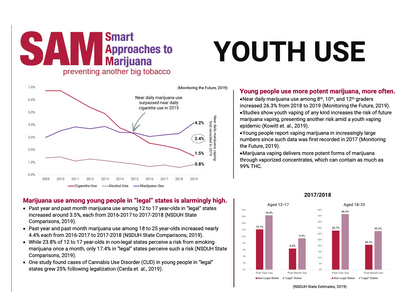Youth Use goes up
/Some people think, “kids use pot, because it’s forbidden.” Sure, some kids are motivated by this and things like, “because you told me ‘no,’ I will do everything in my power to defy you.” However, these motivations do not drive population-level increases in drug use.
Increases in “access” and reduction in the “perception of harm” are the types of trends that drive population-level increases in drug use. “Visibility” increased by advertising, promotion and open use drive substantial use as well. These three environmental changes are found in all states that legalize, and we see increasing youth use in state-level data.
THC vaping doubled from 2017 to 2018, then over tripled from 2018 to 2019 among high school seniors. This represents the 2nd largest increase in use of any substance in The Monitoring the Future Survey 45 year history. See flyer attached for more detail.
The 2019 Healthy Kid Survey in Colorado (the longest running recreationally-legal marijuana marketplace) showed over a 100% increase in high school students who dab. 20.3% of high schoolers who use marijuana in Colorado reported dabbing in 2017; 52% report dabbing in 2019. Dabs are a solid-like concentrate, which is close to 100% pure THC. Dabs and dabbing are extremely dangerous for all users and particularly so for those with developing brains (12-25 year olds).
Since 2014, 18-25 year olds have been the number one user group of marijuana per-capita and 12-17 year olds have been the number two user group of marijuana per-capita. This begs the question, “why legalize at all to pump more marijuana into these vulnerable communities.” This data is based on The National Study on Drug Use and Health - an important study - directed by the Substance Abuse and Mental Health Services Administration (SAMHSA), an agency in the U.S. Department of Health and Human Services and has been conducted since 1971. Of note, the recently released 2019 data shows 26+ year olds nudged 12-17 year olds out of the number two spot nationally, but not in most states.




